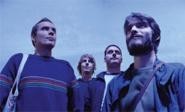
"I think it's just really personal, actually," says Sigur Rós' singer and guitarist, Jonsi Birgisson, by phone from his home in Reykjavík. The new album is "more joyful and has more hope," he adds, because "when we did the Takk . . . album, we all had grown a bit and got more mature."
Birgisson was less forthcoming when Sigur Rós' breakthrough second album, Àgaetís Byrjun, was making waves on distant shores in 2000 and 2001. Back then, the group gave only grudging and erratic interviews, canceling one at the last minute with England's influential New Musical Express while granting another to the Shetland Seafood Journal. And when they did talk, the four band members were almost as unforthcoming as Àgaetís Byrjun itself, a disc that included almost no credits and featured lyrics sung in Icelandic, a language spoken by fewer than 300,000 people.
For non-Icelanders, the imagery conjured by Àgaetís Byrjun swelled to fill the information void like the sea rushing into a narrow fjord. Led by Birgisson's swooping falsetto and bowed guitar, the album's funereal tempos and huge minor chords inspired comparisons to gray skies, creeping glaciers, and volcanic geysers in just about every press story. "Magazines always want to photograph us in front of a geyser," complained keyboardist Kjartan Sveinsson to Q in 2002. "But it's a cliché to us, like photographing an English band in front of Tower Bridge."
But it was more complicated than that. For consumers and critics, the rocky and icy imagery encapsulated both the myth-shrouded romanticism of the band (Birgisson has sometimes talked about performing with Icelandic rimnamenn, male chanters of ancient Viking tales) and the modernist chill of the group's dark chords and plodding minimalism (at one time it was heavily reported that Sigur Rós was the favorite band of Radiohead's Thom Yorke). But for its part, Sigur Rós didn't want to ride prog-rock grandeur to Valhalla. The band sought a purely aesthetic experience that transcended the cold world and cool myths alike. In unguarded moments, Birgisson was even heard to proclaim that this sonic stake was so radical, it would change musical history -- as if every band from Pink Floyd to My Bloody Valentine to friggin' Enya hadn't plowed some of the same volcanic ash beforehand.
"It's probably easy to categorize our music, and that's just fine," says Birgisson now. "Maybe when we were younger, maybe we made some claims -- we made a lot of claims. Like, you know, when we were starting the music and we didn't know this music industry, we thought, 'Wow, this industry is so weird, is so corrupted, is so bad. People who work in it are only in it for the money . . . We have to, like, change the music industry! We have to do something!' You know, it's easier said than done."
Instead, the band has concentrated on changing itself. After purifying its sound on 2002's dour and infamously titled interim album, ( ), Sigur Rós has returned to a broader palette on Takk . . . by varying everything -- tempos, dynamics, arrangements, even composition styles -- and then brightening the color of all of it. At least one cut, "Hoppípolla," could actually pass as a more or less straightforward power ballad.
Sure enough, this has left the band open to ridicule for displaying limpid romanticism -- especially since at times Birgisson's ethereal warble resembles nothing so much as an androgynous version of Mariah Carey's mechanical canary trill. But this more conventional foray also makes these Norsemen sound more like the individualists they've always claimed to be. That is, they're less like a mythic musical iceberg and more like real-life residents of the world's furthest-flung hip cosmopolitan center.
"[Reykjavík] is a small city, but also a really big," explains Birgisson in a choppy rush. "Everything is really up to date. Everybody has a computer. There's a lot of nighttime -- in the winters there isn't nearly any sun. There's a lot of energy. We don't have a big history of music, so maybe people are less afraid to just go out and do something without thinking about it. When I was growing up, you start in a band, and just because you're playing with your friends and it's so fun and it gives you so much, it kind of really fuels your soul."
As the dippy extremes on Takk . . . prove, that unschooled DIY inventiveness has its drawbacks, but the album's fearless combination of the sophisticated and naive can at moments be unexpectedly and thoroughly disarming.
And how does the group make such static music engaging in a live setting? "Ah, you just have to come and see," says Birgisson.

